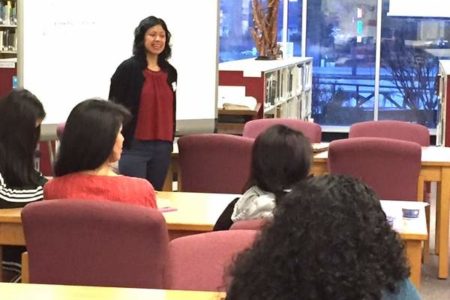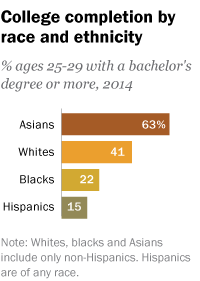
Share On Social!
The road from high school to college isn’t easy for Latinos.
They may speak mainly Spanish. They often lack resources and legal documentation. Some aren’t prepared for complex financial aid and college applications.
That’s why one college readiness program uses cultural competency to help Latinos.
The Juntos program, a six-week Spanish-language workshop offered through Oregon State University, prepares Latino high-school students for higher education and includes ongoing advisement for students and families, according to The Daily Astorian.
Juntos helps Latinos deal with high school graduation requirements, college admission, and getting financial aid─and the workshops include dinner and childcare.
“[Juntos gives Latinos] the keys to be able to open the door to higher education,” Mari Mitchell, a Juntos workshop facilitator, told The Daily Astorian.
How Does Juntos Do College Readiness?

Juntos (“together” in Spanish) began at North Carolina State University in 2007. Oregon State adapted the program in 2012, according to the news report.
Juntos workshops are taught in many parts of Oregon.
“Juntos coordinators work directly with school districts and other community partners to implement programs locally,” according to the news report.
The six-week workshop educate students and parents on the importance of applying for aid and finding a school that best suited them whether it be community college or a university.
The program also arranges college visits and follows up with participants with ongoing counsel.
[Juntos shows families] “what’s possible, especially living in a smaller community,” Ryan Stanley, a Juntos coordinator, told The Daily Astorian.
Why Do Latinos Need Aid?
Latinos may struggle to pursue college due to different socioeconomic factors. The continues upon their collegiate enrollment.
Latino college students are far less likely to complete their degree than their peers.
Educational hindrances before entering college play a factor. Latino kids begin developing, according to a Salud America! research review.
With slow early cognitive development and the lack of engagement in the education by parents contribute to the difficulties Latinos face in school.
Latinos often have less opportunity than their peers to take challenging curriculum including advanced math courses and advanced placement that are often indicative of college success.
More on the Current State of Latino Education
According to Pew Research Center:
- Over the past decade, the Latino high school dropout rate has dropped dramatically. The rate has reached a record low, dropping from 32% in 2000 to 14% in 2013 among those ages 18 to 24 years old. Over the same time period, this has helped lower the U.S. national dropout rate from 12% to 7% – also a record low. However, the Latino dropout rate remains higher than it is among blacks (8%), whites (5%) and Asians (4%).
- Latinos are making big inroads in college enrollment. The number of Latinos ages 18 to 24 enrolled in a two- or four-year college has more than tripled since 1993. In 2013, 2.2 million Latinos were enrolled in college, up from 728,000 in 1993 – a 201% increase. By comparison, college enrollment increased by 78% among blacks and 14% among whites over the same time period. Today, Latinos are the largest minority group on U.S. college campuses.

(Source: Pew Research Center, 2016) Even though more Hispanics are getting a postsecondary education than ever before, Latino students still struggle to finish college. In 2013, among Latinos ages 25 to 29, just 15% of Latinos have a bachelor’s degree or higher. By comparison, among the same age group, about 40% of whites have a bachelor’s degree or higher (as do 20% of blacks and 60% of Asians). This gap is due in part to the fact that Latinos are less likely than some other groups to enroll in a four-year college, attend an academically selective college and enroll full-time.
- Another reason Latinos lag in bachelor’s degrees is that nearly half who go to college attend a public two-year school, the highest share of any race or ethnicity. By comparison, among college-goers, 30% of whites, 32% of Asians and 34% of blacks go to a community college.
- Latinos are significantly less likely than other groups to have student debt. About 22% of young Latino households (those headed by someone younger than 40) have education loans. The share is nearly twice as high among young white households (42%) and young black households (40%). This is because, despite growing college enrollment, young Latinos are not as likely to go to college as some other groups. And among those who do, Latinos are more likely than others to attend community colleges, which generally have lower tuition than four-year school
How can you help?
The Juntos program is a one big way to address many of the issues facing Latinos. It helps break barriers to educational access by making information culturally and linguistically relevant.
Here are a few more suggestions:
- Familial support is important. Parents should work at an early age to be a child’s first teacher.
- High school programs that focus specifically on preparing Latinos students for college should be implemented into Latino communities and schools.
- Families, schools, and communities should be supported and work as a partnership to deliver services and the necessary support that addresses the needs of Hispanic students.
Other programs are trying to help
The state of Oregon hired their first ever “education innovation officer” and schools started finding unique ways to help Latino high schoolers graduate on time. A Georgia middle school started a free, bilingual 12-class program to help Latino parents become school leaders.
Latinos also can choose the right college, which helps their success rates. There are a growing number of Hispanic-serving institutions, too.
You can help: Learn more about Latinos and higher education!
By The Numbers
84
percent
of Latino parents support public funding for afterschool programs



